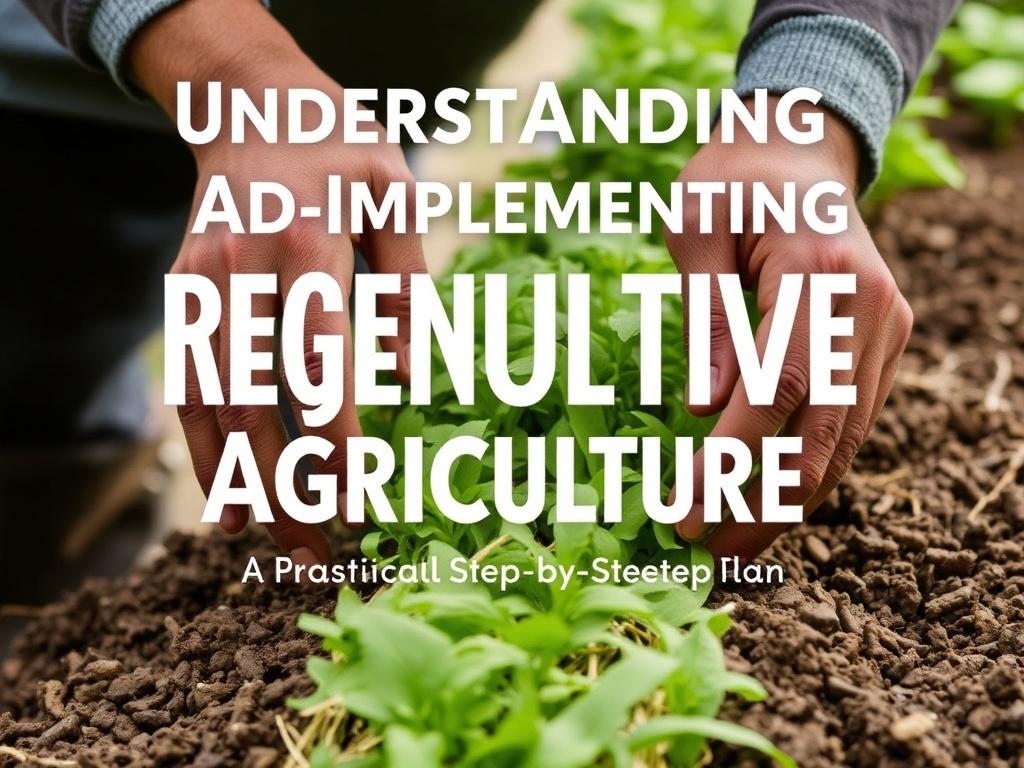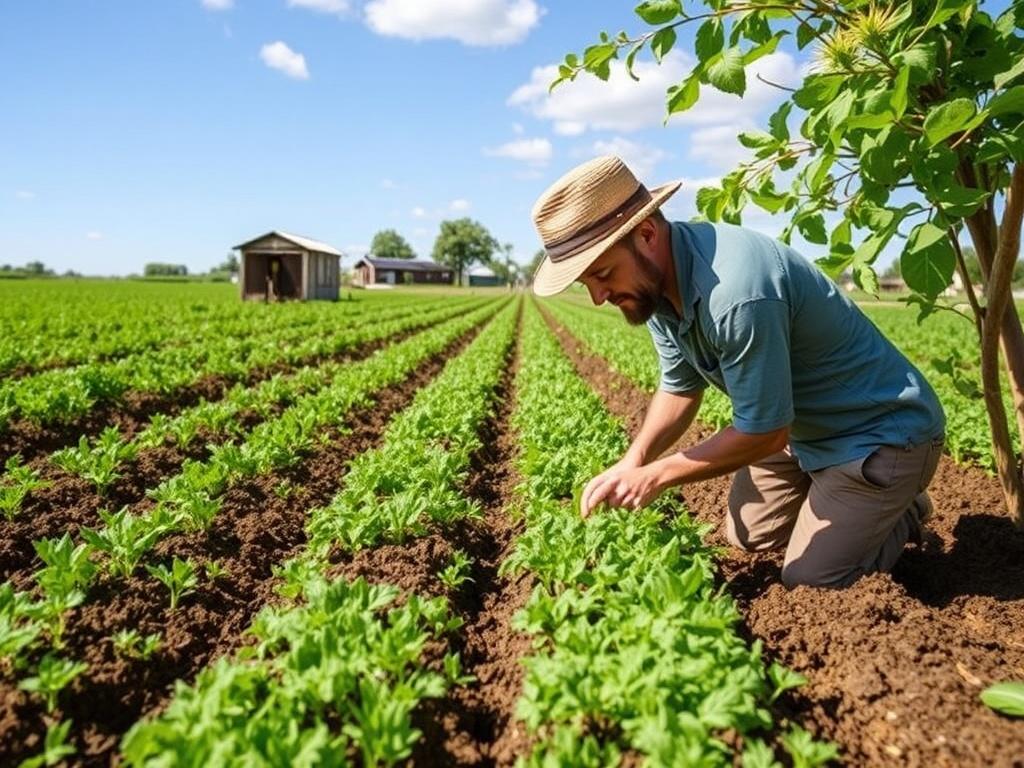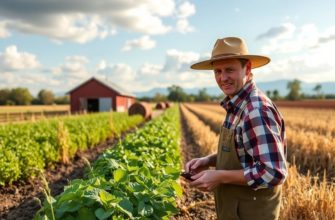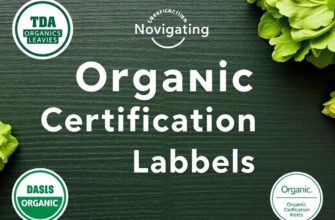Международное название:
Синонимы:
Характеристики:
| Сложность: | |
| Цикл развития: | |
| Световой режим: | |
| Режим полива: | |
| Температура: | |
| Почва: | |
| Ключевая черта: |
Цвет листвы
Цвет бутонов
Размеры цветка
Систематика:
| Домен: | |
| Царство: | |
| Отдел: | |
| Класс: | |
| Порядок: | |
| Семейство: | |
| Род: |
Imagine a farm that doesn’t just take from the land but actively heals it. A place where soil becomes a sponge for water, where small birds and beneficial insects arrive uninvited, and where crops and livestock live in cycles that mirror nature’s rhythms. That is regenerative agriculture — more than a technique, it’s a mindset about how we relate to the land. Whether you are a farmer curious about changing your practices, a consumer wanting to make better food choices, or a policymaker trying to design incentives, this guide will walk you step by step through what regenerative agriculture is, why it matters, and how to put its principles into practice.
This article is long-form because the subject deserves depth. I’ll give you clear definitions, practical practices, a realistic transition plan, tools for measurement, real-world examples, economic considerations, and answers to common concerns. I’ll use simple, conversational language and practical lists and tables so you can return to this as a reference. Let’s dig in.
- What Is Regenerative Agriculture?
- Core Principles
- Why It Matters: Benefits of Regenerative Agriculture
- Environmental Benefits
- Economic and Social Benefits
- Key Practices and How They Work
- 1. Cover Cropping
- 2. Reduced Tillage and No-Till
- 3. Rotational Grazing and Managed Livestock Integration
- 4. Agroforestry and Perennial Integration
- 5. Composting and Organic Amendments
- 6. Diverse Crop Rotations and Polycultures
- 7. Integrated Pest and Nutrient Management
- Comparing Approaches: Regenerative vs Conventional
- How to Transition: A Practical Step-by-Step Plan
- Phase 1 — Learn, Observe, and Plan
- Phase 2 — Start Small and Pilot
- Phase 3 — Scale and Integrate
- Phase 4 — Monitor, Market, and Advocate
- Measuring Success: Metrics and Monitoring
- On-Farm Monitoring (Easy and Routine)
- Laboratory and Technical Metrics (Periodic)
- Landscape and Economic Indicators
- Tools, Technology, and Resources
- Economics, Funding, and Market Opportunities
- Cost Considerations
- Revenue Opportunities
- Financing and Incentives
- Policy, Standards, and Certification
- Emerging Standards
- What to Look For
- Common Challenges and Practical Solutions
- Weed and Pest Pressure
- Short-Term Yield Variability
- Equipment and Knowledge Gaps
- Real-World Examples and Case Studies
- How Consumers and Communities Can Support Regenerative Agriculture
- Consumer Actions
- Community and Policy Actions
- Scaling Regenerative Agriculture: From Fields to Regions
- Market Infrastructure
- Knowledge Networks
- Policy and Finance
- Frequently Asked Questions (FAQ)
- Does regenerative agriculture reduce yields?
- Is regenerative agriculture the same everywhere?
- Can regenerative agriculture feed the world?
- Practical Checklist: Getting Started This Season
- Resources and Further Reading
- Final Thoughts
- Conclusion
What Is Regenerative Agriculture?
Regenerative agriculture is an approach to farming that focuses on rebuilding soil health, increasing biodiversity, improving water cycles, and strengthening the health of ecosystems on agricultural land. Unlike conventional approaches that prioritize yield often at the expense of natural systems, regenerative agriculture aims to create resilient, productive systems that restore rather than deplete.
It is not a single practice but a set of principles and practices that can be adapted to different climates, soils, and cultural systems. Regenerative practices are designed to capture carbon in the soil, reduce erosion, and make farms more resilient to drought, floods, and other climate extremes.
Core Principles
At the heart of regenerative agriculture are a handful of interlinked principles that guide decisions on the farm. These principles are practical and ecological at the same time:
- Prioritize soil health: Build organic matter and encourage living soil biology.
- Keep the soil covered: Use cover crops, mulches, or crop residues to protect soil from erosion and moisture loss.
- Reduce soil disturbance: Minimize tillage to protect soil structure and microbial communities.
- Diversity: Rotate crops, include livestock, and incorporate perennials and trees to create functional biodiversity.
- Integrate animals: Use livestock to cycle nutrients and stimulate plant growth when managed well.
- Close nutrient loops: Compost, use local manures, and reduce reliance on synthetic inputs where possible.
Why It Matters: Benefits of Regenerative Agriculture
There are ecological, economic, and social reasons for the growing interest in regenerative agriculture. The benefits appear at multiple scales — from a single field to whole watersheds and global climate systems.
Environmental Benefits
One of the most talked-about benefits is enhanced carbon sequestration. Healthy soils with high organic matter can store significant amounts of carbon, helping mitigate climate change. But the advantages go beyond carbon.
- Improved soil structure and water infiltration reduce runoff and erosion.
- Greater biodiversity — from microbes to pollinators — increases system resilience and reduces pest pressure over time.
- Reduced need for synthetic inputs decreases pollution of waterways and enhances ecosystem health.
Economic and Social Benefits
Economically, regenerative systems can lower input costs, stabilize yields over time, and open new market opportunities for differentiated products. Socially, regenerative agriculture can support local communities through shared knowledge, improved farm viability, and healthier food systems.
Key Practices and How They Work

Regenerative agriculture is about combining multiple practices in ways that work for the land and people involved. Below are the most widely used practices, why they matter, and hints on how to implement them.
1. Cover Cropping
Cover crops are plants grown primarily to cover the soil — not for harvest. They protect against erosion, add organic matter, fix nitrogen, and keep beneficial root systems active through the seasons.
- Benefits: Reduces erosion, increases soil organic matter, suppresses weeds, and feeds soil life.
- Implementation tips: Choose species suited to your climate (e.g., legumes for nitrogen fixation, grasses for biomass). Plant after harvest or in fall and terminate before the next cash crop using mowing, rolling, or grazing rather than deep tillage.
2. Reduced Tillage and No-Till
Minimizing soil disturbance preserves soil structure, fungal networks, and carbon. No-till means planting crops without turning the soil over with plows.
- Benefits: Maintains soil aggregates, reduces erosion, and supports microbial and fungal communities.
- Implementation tips: Use specialized no-till drills or planters. Manage residues and cover crops to avoid compaction. Transition gradually if your soil currently depends on tillage to control weeds.
3. Rotational Grazing and Managed Livestock Integration
Grazing animals are not the enemy; when managed carefully, they mimic natural herbivore movements and support pasture regeneration. Rotational grazing moves animals frequently to avoid overgrazing and encourage plant recovery.
- Benefits: Recycles nutrients, improves pasture diversity, increases soil organic matter, and controls some weeds.
- Implementation tips: Plan paddock sizes based on herd size and growth stage of forage. Use temporary fencing and water systems to control movement. Monitor plant residuals and recovery time to avoid overuse.
4. Agroforestry and Perennial Integration
Incorporating trees and shrubs with crops and/or livestock increases system complexity and resilience. Agroforestry can include silvopasture (trees + pasture + livestock), alley cropping (rows of trees with crops between), and forest farming.
- Benefits: Provides shade, stabilizes soils, diversifies income, and stores carbon long-term.
- Implementation tips: Choose species with local adaptability and market value. Start small — integrate windbreaks or tree alleys before scaling up.
5. Composting and Organic Amendments
Compost turns organic waste into rich soil amendment that feeds soil life and builds organic matter faster than many other inputs.
- Benefits: Improves soil structure and water-holding capacity, increases nutrient availability, and supports beneficial microbes.
- Implementation tips: Use on-farm residues where possible. Ensure proper carbon-to-nitrogen ratios and sufficient curing time to avoid pathogens or nitrogen lock-up.
6. Diverse Crop Rotations and Polycultures
Rotating crops and growing multiple species together breaks pest cycles, improves nutrient cycling, and supports soil life. Polycultures and intercropping mimic natural plant communities for greater resilience.
- Benefits: Reduces pest and disease pressure, builds soil fertility, and spreads economic risk.
- Implementation tips: Design rotations that include deep-rooted species to scavenge nutrients and legumes to fix nitrogen. Consider companion planting strategies that benefit both crops.
7. Integrated Pest and Nutrient Management
Instead of relying solely on chemical controls, integrated strategies use physical, biological, and cultural tactics to manage pests and nutrients.
- Benefits: Reduced chemical use, preserved beneficial insects, healthier ecosystems, and often reduced input costs.
- Implementation tips: Monitor pest thresholds, encourage beneficial predators, and use targeted, minimal interventions when necessary. Apply nutrients precisely and use soil tests to guide decisions.
Comparing Approaches: Regenerative vs Conventional
It helps to see the differences side by side. The following table summarizes key contrasts in goals, practices, and expected outcomes.
| Feature | Conventional Agriculture | Regenerative Agriculture |
|---|---|---|
| Main focus | Maximizing yield per growing season | Long-term soil health and ecosystem function |
| Soil management | Frequent tillage, fertilizer-driven | Minimal tillage, cover crops, organic matter building |
| Input reliance | High use of synthetic fertilizers and pesticides | Reduced synthetic inputs, emphasis on biological processes |
| Biodiversity | Often low within fields | High, through rotations, cover crops, and integration |
| Resilience | Vulnerable to extreme events without buffer | Higher resilience to droughts and floods via improved soil |
How to Transition: A Practical Step-by-Step Plan

Transitioning to regenerative agriculture is a journey, not an overnight flip. The right path depends on your land, finances, markets, and family. Still, the following phased roadmap gives a practical starting point.
Phase 1 — Learn, Observe, and Plan
- Assess your land: Soil tests, field mapping, and a review of water flow and erosion hotspots.
- Set goals: Are you trying to reduce inputs, increase soil organic matter, diversify income, or all of the above?
- Build knowledge: Visit other farms, join a farmer network, and read region-specific resources.
Phase 2 — Start Small and Pilot
- Choose one field or paddock to pilot practices like cover crops or reduced tillage.
- Keep records: Track costs, yields, soil tests, and observations about pests and weeds.
- Adjust: Use results to refine your approach before expanding.
Phase 3 — Scale and Integrate
- Expand successful practices across more acres in manageable increments.
- Integrate livestock, trees, and diverse crops where appropriate.
- Invest in equipment that supports your system — no-till planters, electric fencing, composting infrastructure.
Phase 4 — Monitor, Market, and Advocate
- Monitor long-term soil health and ecosystem indicators (see monitoring section below).
- Explore markets that reward regenerative practices — direct-to-consumer, local restaurants, cooperatives, or certification programs.
- Share results with peers and policymakers to build wider support.
Measuring Success: Metrics and Monitoring
To know if regenerative practices are working, we need metrics. Some are simple and on-farm, while others require lab tests or remote sensing tools. A balanced monitoring plan includes short-term indicators and long-term soil health metrics.
On-Farm Monitoring (Easy and Routine)
- Visual observations: Plant vigor, diversity, and signs of pests or disease.
- Soil structure checks: Dig a small pit to assess roots, aggregation, and earthworm counts.
- Water infiltration tests: Time how long it takes for a set volume of water to soak in.
Laboratory and Technical Metrics (Periodic)
- Soil organic carbon content: Tracks carbon sequestration over time.
- pH, nutrient levels, and cation exchange capacity: Guides fertility decisions.
- Microbial biomass and diversity assays (when available): Give insight into biological health.
Landscape and Economic Indicators
- Yield stability and input costs: Compare across years and fields.
- Biodiversity counts: Pollinator or bird surveys if relevant.
- Water quality tests downstream: Look for reductions in nutrient runoff.
Tools, Technology, and Resources
Regenerative agriculture benefits from both traditional knowledge and modern tools. Here are accessible options to help with planning, monitoring, and scaling.
- Soil testing labs: Local extension services or private labs provide soil organic matter and nutrient testing.
- Farm mapping and record-keeping apps: Track field activities, rotations, and costs.
- Remote sensing and drones: Useful for monitoring plant health, erosion, and field variability.
- Simple field tools: Infiltration rings, penetrometers, and spades for hands-on assessments.
- Networks and mentorships: Farmer-to-farmer learning circles, cooperative extensions, and nonprofit programs.
Economics, Funding, and Market Opportunities
One of the biggest questions farmers ask is: can regenerative agriculture pay? The answer is “yes, but it depends.” In many systems, input costs fall while resilience and market opportunities grow — but the transition period requires planning and, sometimes, financial support.
Cost Considerations
Initial investments may include new equipment, fencing for rotational grazing, seed for cover crops, and composting infrastructure. Labor patterns may change, and yields may fluctuate during transition years. However, many farmers experience reduced fertilizer and pesticide costs over time.
Revenue Opportunities
- Premium markets: Some consumers are willing to pay more for products labeled regenerative or sourced from soil-building farms.
- Direct sales and CSA models: Local customers often value the story and stewardship behind regenerative products.
- Carbon markets and ecosystem service payments: Emerging programs pay farmers for verified carbon sequestration or watershed benefits.
Financing and Incentives
Look for government cost-share programs, conservation grants, low-interest loans from agricultural lenders, and nonprofit funding aimed at sustainable agriculture projects. Cooperative ventures and community-supported investment models can also spread risk.
Policy, Standards, and Certification
Policy plays a major role in encouraging or discouraging regenerative practices. Subsidies, crop insurance, and conservation programs are all levers that can be used to accelerate adoption.
Emerging Standards
Regenerative agriculture is diverse and sometimes loosely defined, which creates both flexibility and confusion. Some third-party certification programs have emerged to provide standards and verification. These can help farmers access premiums, but they also add paperwork and costs.
What to Look For
- Transparent criteria: Clear, measurable practices and outcomes, not just buzzwords.
- Reasonable verification: Site visits, remote sensing, and farmer records balanced to avoid undue burden.
- Market recognition: Programs that are recognized by buyers and consumers.
Common Challenges and Practical Solutions
No system is perfect. It helps to anticipate common obstacles and how other farmers have overcome them.
Weed and Pest Pressure
Some farmers see increased weeds during the transition from intensive tillage. The solution is to combine cover crops, targeted grazing, and mechanical or thermal weed controls, and to accept that a few seasons of extra labor may be part of the transition.
Short-Term Yield Variability
Yields may dip as soil systems reorganize. To manage risk, keep diversified revenue streams, use part of the farm as a test plot, and use financial buffers such as savings or insurance programs.
Equipment and Knowledge Gaps
New practices sometimes require new tools and knowledge. Join farmer networks, access extension programs, and consider renting or sharing equipment to reduce capital outlays.
Real-World Examples and Case Studies
Stories help bring ideas to life. Here are a few anonymized examples of how real farms implemented regenerative practices and what they saw.
- Family Grain Farm in the Midwest: Switched to cover crops and strip-till on 25% of acreage, reducing nitrogen fertilizer use by 30% over three years and improving soil organic matter by 0.5 percentage points in long-term fields.
- Mixed Livestock Operation in the Southeast: Implemented rotational grazing and silvopasture, which improved pasture productivity, reduced feed purchases, and increased bird and pollinator diversity.
- Small Vegetable Grower in the West: Used compost, no-till beds, and polycultures to reduce irrigation needs and attract beneficial insects, enabling a premium CSA and stable revenues despite regional drought pressures.
How Consumers and Communities Can Support Regenerative Agriculture

Farmers don’t operate in isolation. Consumers, retailers, and communities have leverage to accelerate adoption through purchasing decisions, local policies, and support programs.
Consumer Actions
- Buy local and seasonal produce from farms practicing regenerative methods.
- Ask questions at markets and stores about how food is grown — demand builds supply.
- Support brands that are transparent about regenerative sourcing.
Community and Policy Actions
- Encourage local procurement by institutions (schools, hospitals) that prioritize regenerative suppliers.
- Support funding and training programs that help farmers transition.
- Advocate for policies that reward ecosystem services and remove perverse incentives that favor depletion.
Scaling Regenerative Agriculture: From Fields to Regions
Scaling is not just about copying practices across acres; it’s about creating supply chains, markets, and policy ecosystems that recognize and reward regenerative outcomes. Here are key components to scale successfully.
Market Infrastructure
Processors, distributors, and retailers need to be willing to handle products from varied systems. Cooperative models and regional food hubs can help aggregate supply and match it to demand.
Knowledge Networks
Scaling requires farmers learning from each other and from scientists. Extension services, demonstration farms, and peer networks are critical.
Policy and Finance
Long-term financing, insurance products suited to diversified systems, and conservation incentives help reduce transition risk and reward public benefits like carbon sequestration and improved water quality.
Frequently Asked Questions (FAQ)
Does regenerative agriculture reduce yields?
Short-term yields can be variable during transition, but many farmers see yields stabilize or even improve over time, especially when accounting for reduced input costs and greater resilience to stressors.
Is regenerative agriculture the same everywhere?
No. It must be adapted to local climates, soils, and social systems. The core principles are universal, but practices differ — that’s part of its strength.
Can regenerative agriculture feed the world?
Regenerative agriculture aims for resilient, healthy production systems. While yield per acre is one metric, the approach emphasizes sustainability and equitable food systems. Many experts believe a mix of practices and reduced food waste alongside dietary shifts can sustain global needs more healthfully than current high-input models.
Practical Checklist: Getting Started This Season
If you’re a farmer ready to try something this coming season, here’s a practical checklist to help you begin without becoming overwhelmed.
- Conduct a basic soil test and map erosion hotspots.
- Choose one or two regenerative practices to pilot (e.g., a cover crop mix, reduced tillage, or a rotational grazing plan).
- Arrange seed, compost, or equipment now so you’re ready at the right time of year.
- Create a simple monitoring plan: take photos, keep yield records, and measure infiltration.
- Connect with one local farmer who’s tried similar practices for mentorship.
Resources and Further Reading
There are numerous organizations, books, and online platforms dedicated to regenerative agriculture. Look for local extension services, farmer networks, and reputable NGOs that provide region-specific guidance. Combining in-person learning with curated reading can accelerate progress.
Final Thoughts
Regenerative agriculture is a hopeful and practical pathway forward. It asks us to rethink short-term extraction and instead invest in systems that sustain life — soil life, plant life, animal life, and human communities. It doesn’t promise instant fixes, but it offers a durable route to healthier soils, more resilient farms, and richer ecosystems. The transition is neither simple nor one-size-fits-all, but with careful planning, shared knowledge, and supportive markets and policies, regenerative practices can be scaled to benefit farms, consumers, and the planet alike.
Conclusion
If you take one thing away, let it be this: regenerative agriculture is both an ethic and a toolbox — an ethic that values restoration and care for the land, and a toolbox of practical practices that can be adapted to local conditions. Start small, measure what matters, stay flexible, and build a community around learning. Over time, those small changes add up to healthier soil, more resilient farms, and a stronger future for all of us.
Оценивайте статью, делитесь материалом с друзьями в социальных сетях, а также высказывайте свое мнение в обсуждении ниже! ![]()






